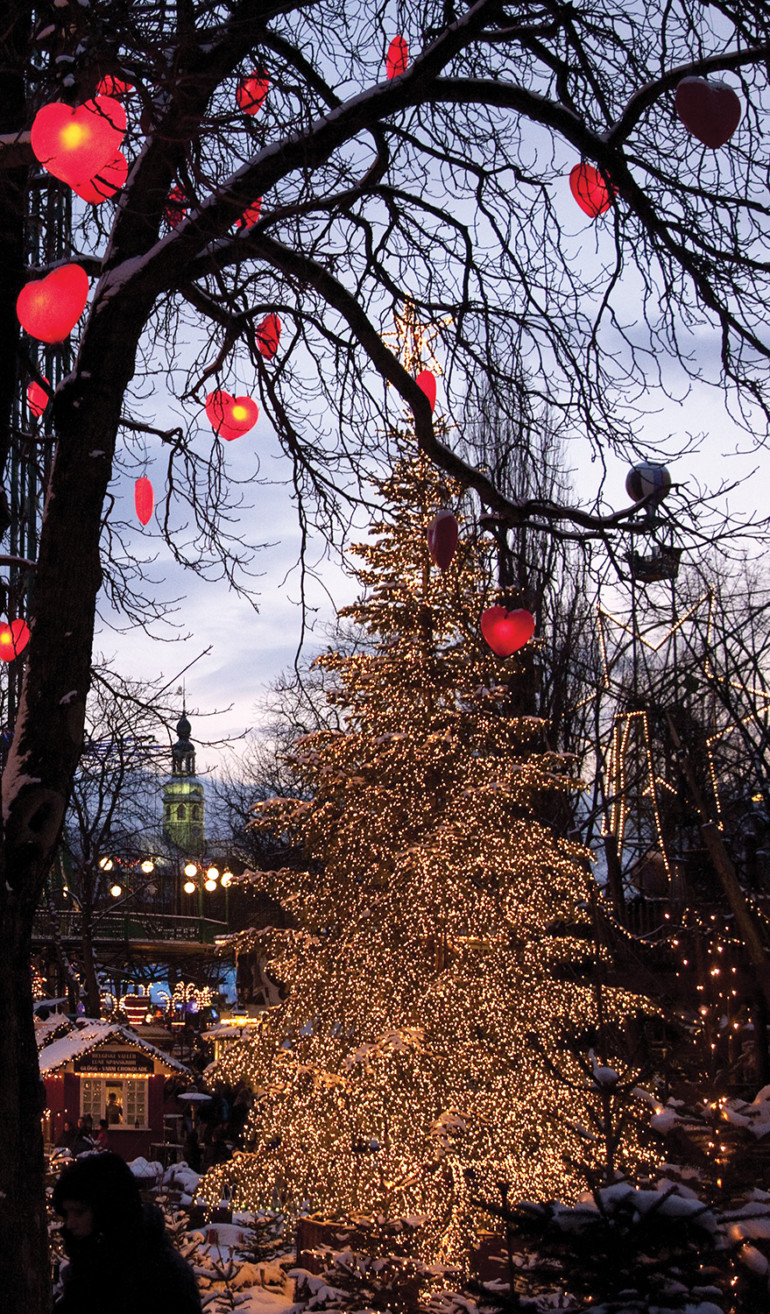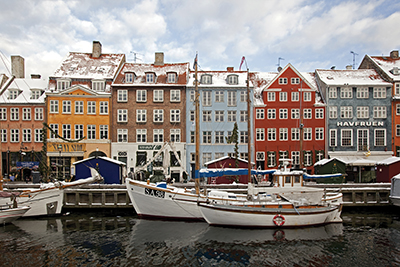
Nyhavn’s harbor canal.
YOU MIGHT THINK it’s cold and dark in Denmark in December. (It is.) You might suspect that Denmark’s smattering of islands has no altitude worth shaking a ski at. (It’s true.) What you might not know is that what this royal kingdom lacks in balminess and vertical drop is massively compensated for by hygge (pronounced hoo-ge) — a uniquely Danish term, which encompasses all that is warm, cozy and festive. While hygge is ever present in the Danish culture as a desired state of, well, happiness, the best time to experience hygge is in the winter, and there is no better place than Copenhagen at Christmas.
Denmark’s cosmopolitan capital, a former Viking fishing village and medieval fortification perched on the eastern shores of the island of Zealand, is an elegant contrast of classic and modern, timelessly reflecting an ingrained balance of Scandinavian tradition and contemporary sensibilities. Home to the world’s oldest monarchy and a relaxed, open-minded population, a 1,000-year-old Viking heritage and oodles of Danish design icons, historic castles, cutting edge architecture, gads of bicycles and high-tech windmills, Copenhagen is charming and progressive at once. It’s also home to what some studies say are the happiest people on the planet. And while Danish happiness can certainly be credited to Copenhagen’s many charms, it also, quite likely, has something to do with Christmas.
From the first day of Advent until the fireworks of the New Year, every day is a celebration. Danes and tourists flock to Copenhagen to shop the markets, admire the displays and generally indulge in copious amounts of eating, drinking and partying. Old-fashioned Christmas markets fill the city squares with timber stalls displaying handcrafted decorations, chestnuts roasting on fires and kiosks doling out sugar-dusted æbleskivers (pancakes) and mugs of steaming gløgg (mulled wine). Fir garlands and strings of white lights tastefully drape and link the picturesque streets lined with gleaming shops displaying sleek Danish wares, elegant porcelain and artisanal crafts. Crooked half timber buildings housing ancient tea shops, trendy bars and whitewashed cafes beckon with flickering candles. Tivoli, one of the world’s oldest amusement parks, is awash in hundreds of thousands of twinkling lights, its maze of torch-lit paths winding around carnival rides, ice sculptures, grazing reindeer and award-winning restaurants. Sure, it might be cold outside, but Copenhagen is bright and festive, oozing holiday spirit in a seamless blend of old and new.
It’s understandable that the notion of a Nordic winter might give travelers from warm-weather California pause. For inspiration and answers, look to the Danes, who do dark and cold so well. Take their cues and you will be well on your way to a hyggelig holiday. Just remember to pack your mittens.
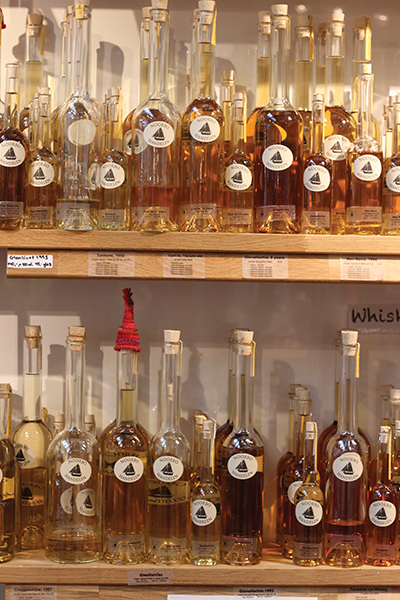
Snaps at Torvehallerne.
Drink Frequently
To get into the spirit, drink plenty of snaps (a distilled spirit flavored with botanicals, traditionally poured as a shot). Year round, this national pastime is considered the equivalent of a morning coffee, an aspirin and a sleep aid. In the winter, snaps is embraced as an effective heating element, and at Christmastime it’s a requisite table accessory; celebratory lunch and dinner courses are punctuated by shots of Gammel Dansk. If spirits are not your thing, no worries. Denmark is blessed with hops, which means there is plenty of beer worth sampling — especially at Christmas when the local breweries roll out their holiday specials, appropriately concocted and fortified to warm the heftiest Viking.
Mind the Bikes
When imbibing (and any other time for that matter), watch out for the bikes — even in the dead of winter. In this eco-friendly and proudly DIY nation, bikes are the green vehicle of choice, considered the sacred cow of transportation and arguably a national symbol on par with the Little Mermaid and Lego. In all of their forms (and there are many), bicycles always have the right of way, whether you are on foot or driving (which you would not be if you are drinking snaps). The only difference in the winter is that the bikes are moving faster because it’s cold.
Stay Warm
Got boots and a parka? Then you are good to go. In fact, take a good look at Nordic winter fashion exquisitely displayed in swanky Illum and the designer boutiques lining the shopping streets (or even better, modeled by the gorgeous Danes themselves). Scandinavian design does not merely apply to stackable side chairs and wine decanters. Sumptuous downs, fluffy fleece, elegant furs, darling woven and knitted accessories are guaranteed to bring hygge to your wardrobe. You will be craving the cold and snow faster than you can say Hans Christian Andersen, grateful for the excuse to indulge in a Christmas shopping spree, so you can wrap and pull on warming layers, scarves, throws and boots. Still not convinced? Then drink more snaps.
Prepare to Walk
All the outerwear will come in handy when you are walking, which is the best way to see this compact and accessible city. Copenhagen is easily navigated along Strøget, the longest pedestrian street in Europe, connecting Rådhuspladsen (City Hall Square), with its monumental Christmas tree at one end, to Kongens Nytorv, the elegant plaza at the foot of Nyhavn, the colorful and iconic harbor canal. Along the two-kilometer stroll are elegant flagship shops guaranteed to satisfy every design, fashion and gastronomic whim, high- and low-end boutiques, cobblestoned squares and grand plazas lined with cafes, restaurants and bars. If the status quo and fellow tourists are not your thing, there are plenty of side streets and crooked passageways to veer into and explore, leading to half-timbered enclaves, fashionable neighborhoods and monuments. The Royal Palace and the Parliament at Christiansborg Palace are a walking bridge and stroll away; wander along the canals of Christianshavn, the arty residential neighborhood lined with houseboats, lofts and cafes; sip an espresso in the hip and funky Latin Quarter, original home to Copenhagen’s 500-year-old university; or if you crave a trendy experience, head to Kødbyen, the edgy meatpacking district, where you can mingle with butchers, baristas and bartenders.
Embrace the Dark
Just because the sun sets in the afternoon doesn’t mean it’s time to retire. Quite the contrary, this is the best time to be out and about, admiring the full monty of twinkling lights 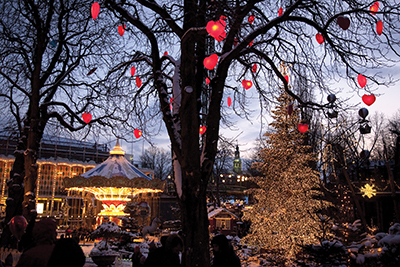 glowing in the dusk. The pedestrian streets, Tivoli and Christmas markets are at their prettiest as the day grows dim, and luckily that applies to a good chunk of the winter day. The setting sun is also an excuse to take a warming break indoors. Stroll through the city’s many galleries and world-class museums and drink in the rich Danish culture, Norse history, ancient and modern art and royal jewels. Or relax and treat yourself to an apero at the champagne bar in the elegant and historic Hotel D’Angleterre, and watch the passersby and ice skaters from the great windows overlooking Kongens Nytorv; or duck into Mikkeller and choose from the 15 brews on tap (tip: for immediate gratification you can also check out the San Francisco location); or if you crave something sweet, indulge in a slice of lagkage (layered cake) at La Glace, the city’s oldest konditori, or a gluten-free cake at Emmerys. Just be sure to save your appetite for dinner, because you will need it.
glowing in the dusk. The pedestrian streets, Tivoli and Christmas markets are at their prettiest as the day grows dim, and luckily that applies to a good chunk of the winter day. The setting sun is also an excuse to take a warming break indoors. Stroll through the city’s many galleries and world-class museums and drink in the rich Danish culture, Norse history, ancient and modern art and royal jewels. Or relax and treat yourself to an apero at the champagne bar in the elegant and historic Hotel D’Angleterre, and watch the passersby and ice skaters from the great windows overlooking Kongens Nytorv; or duck into Mikkeller and choose from the 15 brews on tap (tip: for immediate gratification you can also check out the San Francisco location); or if you crave something sweet, indulge in a slice of lagkage (layered cake) at La Glace, the city’s oldest konditori, or a gluten-free cake at Emmerys. Just be sure to save your appetite for dinner, because you will need it.
Sample the Fare
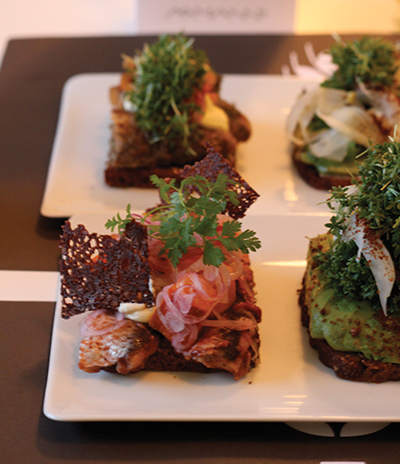 Copenhagen has catapulted to the top of the international culinary world, with no fewer than 15 Michelin-starred restaurants and a slew of noteworthy eateries creating traditional fare and innovative Nordic cuisine. Classic and modern coexist in a laundry list of venues dishing out Christmas must-haves such as herring and roasted pork with crispy cracklings and smørrebrød, the artful open-face sandwich that multitasks as a holiday starter and a substantial lunch. Try Kähler in Tivoli, a pristine mid-century time capsule, for gastronomic smørrebrød compositions served on its award-winning pottery, or experience Aamann’s for clever and minimal selections inspired by the farmers’ market — think Scandinavian Design on a plate.
Copenhagen has catapulted to the top of the international culinary world, with no fewer than 15 Michelin-starred restaurants and a slew of noteworthy eateries creating traditional fare and innovative Nordic cuisine. Classic and modern coexist in a laundry list of venues dishing out Christmas must-haves such as herring and roasted pork with crispy cracklings and smørrebrød, the artful open-face sandwich that multitasks as a holiday starter and a substantial lunch. Try Kähler in Tivoli, a pristine mid-century time capsule, for gastronomic smørrebrød compositions served on its award-winning pottery, or experience Aamann’s for clever and minimal selections inspired by the farmers’ market — think Scandinavian Design on a plate.
While the traditionalists are tucking into their rice pudding, a number of Danish chefs are paying homage to their Scandinavian roots while propelling Denmark’s unfussy cuisine to new levels, crafting innovative farm-to-table plates, prepared with foraged and sustainable ingredients. At the forefront of Copenhagen’s New Nordic food movement is Rene Redzepi’s Noma, crowned best restaurant in the world three times, which unfortunately makes it one of the most difficult tables to book. Fortunately, there are plenty of other locally celebrated chefs creating equally inspired cuisine. Claus Meyer, a cofounder of Noma, has a collection of restaurants, including the always-fresh Radio in the leafy neighborhood of Frederiksberg, and The Standard, a jazz music and restaurant emporium in Nyhavn’s renovated Customs House. Relæ, helmed by Chef Christian Puglisi, prides itself on a no-nonsense and unpretentious gastronomic experience with a Michelin star to boot. If choosing from restaurant menus is not your forte, then head directly to Torvehallerne, a glass-and-steel food hall, filled with cafes, bars and more than 60 stalls selling delicacies and artisanal foods from Denmark and beyond.
Get Out of Town
Luckily, the Christmas spirit extends beyond Copenhagen’s center, and the region’s small size, efficient train system and affordable car rentals make excursions an easy proposition. Head north along Strandvejen, a coastal road winding through posh residential neighborhoods, to Klampenborg, home to a cluster of Arne Jacobsen buildings and Dyrehaven, the old royal hunting grounds where you can find hundreds of deer, ancient oak trees and a popular winter sledding venue. Stop in the tiny village of Skovshoved, where thatched-roof cottages and walled villas mingle with diplomatic residences. Nestled in the center of the picturesque enclave is Skovshoved Hotel, dating back to 1660 as a stopping point and watering hole for weary travelers. Today it’s a charming and hip hotel, with a bright Danish-French brasserie and pub — perfect for a 21st-century pit stop.
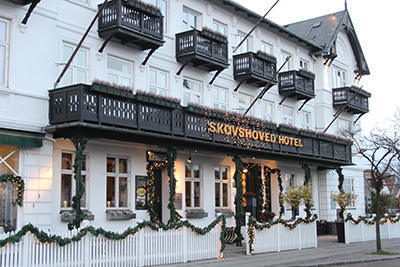 Continue up Strandvejen to Humlebæk, where you will discover the Louisiana Museum of Modern Art perched on a bluff overlooking the Øresund strait separating Zealand from Sweden. It houses an extensive permanent collection of contemporary art displayed throughout the villa-museum and the rolling grounds, themselves an impressive integration of art, architecture and landscape, and is well worth the stop.
Continue up Strandvejen to Humlebæk, where you will discover the Louisiana Museum of Modern Art perched on a bluff overlooking the Øresund strait separating Zealand from Sweden. It houses an extensive permanent collection of contemporary art displayed throughout the villa-museum and the rolling grounds, themselves an impressive integration of art, architecture and landscape, and is well worth the stop.
From there continue north along the coast to Helsingør, where Kronborg Castle, Hamlet’s old haunt, is ominously perched at the northeastern tip of Zealand with a watchful eye to Helsingborg, Sweden. Throughout the month of December, the castle’s vaulted cellars transform into a medieval Christmas market with arts and crafts, sweets and gløgg, while its surrounding half-timbered ancillary buildings host local artist expositions. Cross the moat and stroll into the historic cobblestoned trading town, past the subterranean glass-and-concrete Maritime Museum, evoking a submerged ship and somehow completely in sync with its medieval surroundings. For a late lunch step down into the 17th-century Rådmand Davids Hus, a lopsided cafe with an equally crooked interior, and enjoy a traditional “shoppers’ lunch” — a hearty platter of smoked fish and herring washed down with a cold Christmas beer.
By now, you will have traveled a mere 30 miles, yet you will have spanned a millennia of history, design and culture. If castles are still on your mind and you are not ready to return to the city (because you’ve been drinking beer and gløgg), stay overnight at nearby Køkkedal Slot, the only castle on Zealand that doesn’t belong to the royal family or house a museum; the sumptuous 250-year-old residence has been painstakingly restored to its classic splendor with state-of-the-art amenities, a refined Danish restaurant and sparkling views over the sea.
If the city lights beckon, then head back to Copenhagen and treat yourself to a glittering night at Nimb, Tivoli’s 100-year-old Moorish palazzo and the city’s only Michelinstarred hotel. After a dinner at the Nordic-elegant farm-to-table Nimb Terrasse, retire to your luxury customdesigned suite (which could stand in as a Bang & Olufsen showroom) and your private patio opening to Tivoli with views of the midnight fireworks. When you wake in the morning, relaxed, happy and full of hygge, you will agree that fairy tales do indeed come true.
If You Go
GETTING THERE:
- SAS flies direct from SFO to Copenhagen, flysas.com
- Norwegian Air provides service from Oakland to Copenhagen via Oslo, norwegian.com
WHERE TO STAY:
- Admiral Hotel A restored granary providing reasonably priced, modern deluxe accommodations, a short walk from Nyhavn and the Royal Palace, admiral-hotel-copenhagen.com/en
- Hotel D’Angleterre, dangleterre.com
- Nimb Hotel and Terrasse A lavish boutique hotel situated in Tivoli, nimb.dk/en
- Kokkedal Slot, kokkedalslotcopenhagen.dk/en
- Skovshoved Hotel & Restaurant, skovshovedhotel.com
EAT AND DRINK:
- Aamanns, aamanns.dk/us
- Geist, restaurantgeist.dk/en
- Kähler, kahler-i-tivoli.com
- Mikkeller, mikkellerbar.com
- Radio, restaurantradio.dk
- Relæ, restaurant-relae.dk/en
- The Standard, en.thestandardcph.dk
- Torvehallerne, torvehallernekbh.dk

Lynda Balslev is an award-winning food writer, editor and recipe developer based in the San Francisco Bay area. She authors the nationally syndicated column and blog TasteFood, and co-authored the cookbook Almonds: Recipes, History, Culture (2015 Silver Medal Winner Independent Publisher Awards). She is the 2011 recipient of the Chronicle Books Award (Recipe Writing) to the Symposium for Professional Food Writers, and a 2018 Fellowship Award recipient to the Symposium for Wine Writers at Meadowood, Napa Valley. Lynda’s writing and photography have been recognized by the New York Times Diners Journal, the Los Angeles Times, The Huffington Post and more.

